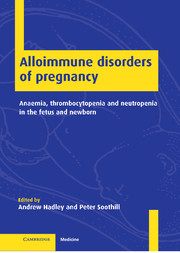 Alloimmune Disorders of Pregnancy
Alloimmune Disorders of Pregnancy Book contents
- Frontmatter
- Contents
- List of contributors
- Preface
- Foreword
- List of abbreviations
- 1 Pathophysiology of the alloimmune cytopenias
- 2 Blood group antibodies in haemolytic disease of the fetus and newborn
- 3 Basis and practice of screening for haemolytic disease of the fetus and newborn
- 4 Epidemiology and screening for alloimmune thrombocytopenia
- 5 Principles of antibody-mediated immune suppression and the prevention of maternal RhD alloimmunization
- 6 The clinical application of anti-D prophylaxis
- 7 Fetal genotyping
- 8 Laboratory assays to determine the severity of haemolytic disease of the fetus and newborn
- 9 Assessing the severity of haemolytic disease of the fetus and newborn: clinical aspects
- 10 Antenatal therapy for haemolytic disease of the fetus and newborn
- 11 Neonatal therapy for haemolytic disease of the newborn
- 12 The diagnosis of alloimmune thrombocytopenia
- 13 The immunological diagnosis of alloimmune neutropenia
- 14 Fetal and neonatal treatment of alloimmune thrombocytopenia
- Index
8 - Laboratory assays to determine the severity of haemolytic disease of the fetus and newborn
Published online by Cambridge University Press: 26 October 2009
- Frontmatter
- Contents
- List of contributors
- Preface
- Foreword
- List of abbreviations
- 1 Pathophysiology of the alloimmune cytopenias
- 2 Blood group antibodies in haemolytic disease of the fetus and newborn
- 3 Basis and practice of screening for haemolytic disease of the fetus and newborn
- 4 Epidemiology and screening for alloimmune thrombocytopenia
- 5 Principles of antibody-mediated immune suppression and the prevention of maternal RhD alloimmunization
- 6 The clinical application of anti-D prophylaxis
- 7 Fetal genotyping
- 8 Laboratory assays to determine the severity of haemolytic disease of the fetus and newborn
- 9 Assessing the severity of haemolytic disease of the fetus and newborn: clinical aspects
- 10 Antenatal therapy for haemolytic disease of the fetus and newborn
- 11 Neonatal therapy for haemolytic disease of the newborn
- 12 The diagnosis of alloimmune thrombocytopenia
- 13 The immunological diagnosis of alloimmune neutropenia
- 14 Fetal and neonatal treatment of alloimmune thrombocytopenia
- Index
Summary
Introduction
The clinical management of alloimmunized pregnancies relies on the use of laboratory assays first to screen for the presence of blood group antibodies and then, once detected, to forecast their potential clinical significance. Screening is discussed in Chapter 3. This chapter considers laboratory tests that measure or characterize blood group antibodies in an attempt to forecast the severity of fetal haemolysis and to identify those cases where amniocentesis or percutaneous fetal umbilical cord blood sampling may be warranted in order to determine more directly the extent of fetal haemolysis. These invasive procedures carry risks, such as transplacental haemorrhage leading to exacerbation of maternal alloimmunization and the worsening of fetal anaemia (Chapter 10). It is important, therefore, that laboratory assays should reliably predict disease severity because failure to do so will expose some pregnancies to these risks unnecessarily.
Numerous techniques have been developed to predict the severity of HDFN. These assays may be serological, quantitative or cellular in nature. In all cases, the aim is to establish thresholds of antibody activity or trends in activity which are predictive of fetal haemolysis. This chapter discusses the advantages and limitations of these approaches, emphasizing the need for a structured and sequential application of assays of increasing complexity in order to generate clinically useful information in a cost-effective manner.
Serological assays
The majority of antibodies which cause HDFN do not agglutinate red cells suspended in saline.
- Type
- Chapter
- Information
- Alloimmune Disorders of PregnancyAnaemia, Thrombocytopenia and Neutropenia in the Fetus and Newborn, pp. 141 - 152Publisher: Cambridge University PressPrint publication year: 2001
- 1
- Cited by


